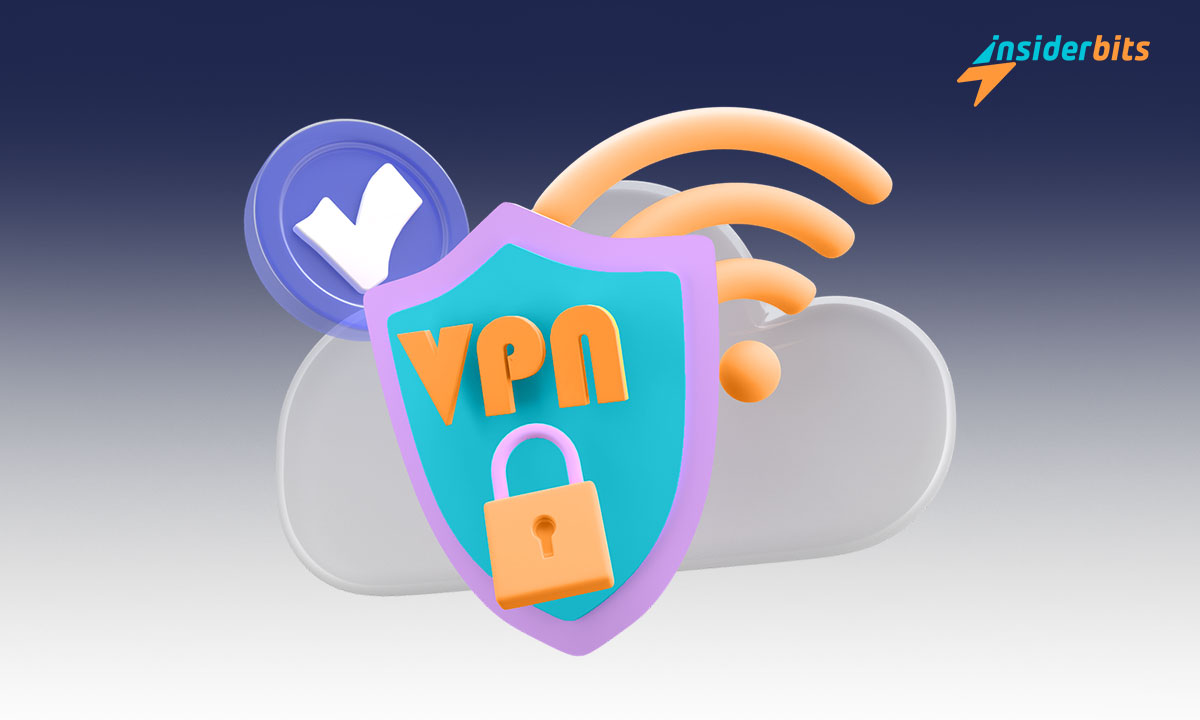In der heutigen digitalen Landschaft wird VPN zu einer beliebten Wahl, da Datenschutzbedenken und Online-Sicherheitsbedrohungen immer präsent sind. Eine zuverlässige Methode zum Schutz Ihrer persönlichen Daten ist von entscheidender Bedeutung.
Das Virtual Private Network stellt eine sichere und verschlüsselte Verbindung über ein weniger sicheres Netzwerk her. VPNs bieten Nutzern eine Möglichkeit, ihre Online-Aktivitäten zu schützen.
Insiderbits hat diesen Artikel verfasst, um zu erklären, was ein VPN ist, wie es funktioniert, um Ihre Privatsphäre und Sicherheit zu schützen, und um eine Schritt-für-Schritt-Anleitung für die Einrichtung eines VPN auf verschiedenen Geräten bereitzustellen.
Was ist ein VPN und warum ist es nützlich?
Ein VPN (Virtual Private Network) ist eine Technologie, die eine sichere und verschlüsselte Verbindung über ein weniger sicheres Netz wie das Internet herstellt.
Es ermöglicht den Nutzern, Daten so zu senden und zu empfangen, als wären ihre Geräte direkt mit einem privaten Netz verbunden.
Dies ist besonders nützlich für den Schutz sensibler Informationen bei der Nutzung von öffentlichem Wi-Fi, wo Daten leicht von Hackern abgefangen werden können.
Zu den wichtigsten Vorteilen eines VPN gehören ein verbesserter Datenschutz und mehr Sicherheit. Durch die Maskierung Ihrer IP-Adresse macht es ein VPN Dritten, einschließlich Internetanbietern und Werbetreibenden, schwer, Ihre Online-Aktivitäten zu verfolgen.
Außerdem sorgt die Verschlüsselung durch ein VPN dafür, dass Ihre Daten vertraulich bleiben und vor möglichen Verstößen geschützt werden.
Zusammenfassend lässt sich sagen, dass ein VPN nicht nur Ihre Daten schützt, sondern Ihnen auch den Zugriff auf geografisch eingeschränkte Inhalte ermöglicht, was es zu einer vielseitigen Lösung in der heutigen digitalen Landschaft macht.
Vorteile der Verwendung eines VPN
- Verbesserter Datenschutz: Ein VPN verbirgt Ihre IP-Adresse, so dass Ihre Online-Aktivitäten schwerer zu Ihnen zurückverfolgt werden können. Diese Anonymität hilft, Ihre persönlichen Daten vor neugierigen Blicken zu schützen.
- Verbesserte Sicherheit: Durch die Verschlüsselung Ihres Internetverkehrs schützt ein VPN Ihre Daten vor potenziellen Cyber-Bedrohungen und gewährleistet, dass sensible Informationen wie Passwörter und Kreditkartennummern sicher bleiben.
- Zugang zu eingeschränkten Inhalten: Viele Menschen nutzen VPNs, um geografische Beschränkungen für Websites und Streaming-Dienste zu umgehen. Indem Sie sich mit einem Server in einem anderen Land verbinden, können Sie auf Inhalte zugreifen, die in Ihrer Region möglicherweise nicht verfügbar sind.
- Sicherer Fernzugriff: In Unternehmen ermöglichen VPNs den Mitarbeitern den sicheren Zugriff auf Unternehmensressourcen von entfernten Standorten aus und gewährleisten, dass sensible Daten geschützt bleiben.
- Vermeiden Sie Bandbreitendrosselungen: Einige Internetdienstanbieter (ISPs) drosseln die Bandbreite für bestimmte Aktivitäten wie Streaming oder Spiele. Ein VPN kann Ihnen helfen, diese Beschränkungen zu umgehen, indem es Ihre Aktivitäten vor dem ISP maskiert.
Wie schützt ein VPN die Privatsphäre und Sicherheit im Internet?
Das virtuelle private Netzwerk verbessert den Online-Datenschutz und die Sicherheit durch mehrere Schlüsselmechanismen.
Erstens verschlüsselt es den gesamten Internetverkehr, so dass abgefangene Daten ohne den Verschlüsselungscode nicht lesbar sind. Die meisten seriösen VPNs verwenden starke Verschlüsselungsprotokolle, wie z. B. die AES-256-Bit-Verschlüsselung, um ein hohes Maß an Sicherheit zu gewährleisten.
Zweitens maskiert ein VPN Ihre tatsächliche IP-Adresse, indem es Ihre Verbindung über seine Server leitet, was nicht nur Ihren Standort verbirgt, sondern auch die Nachverfolgung durch Websites und Werbetreibende erschwert und somit eine größere Anonymität beim Surfen ermöglicht.
VPNs stellen auch in öffentlichen Wi-Fi-Netzen sichere Verbindungen her, was das Risiko von Hackerangriffen oder Datendiebstahl erheblich verringert.
Sie ermöglichen es den Nutzern, geografische Beschränkungen und Zensur zu umgehen, indem sie sich mit Servern in verschiedenen Ländern verbinden.
Schließlich verfügen viele VPNs über Funktionen wie Kill Switches, die Sie vom Internet trennen, wenn die VPN-Verbindung unerwartet abbricht, um die versehentliche Preisgabe Ihrer echten IP-Adresse zu verhindern.
Wie man ein VPN benutzt
Die Einrichtung eines virtuellen privaten Netzwerks auf verschiedenen Geräten ist in der Regel einfach zu bewerkstelligen. Hier erfahren Sie, wie Sie es tun können:
Einrichten eines VPN unter Windows
- Wählen Sie einen seriösen VPN-Dienst, der Ihren Anforderungen entspricht.
- Besuchen Sie die Website des Anbieters oder den Microsoft Store, um dessen Anwendung herunterzuladen.
- Folgen Sie den Installationsanweisungen.
- Öffnen Sie die App und melden Sie sich mit Ihren Kontoanmeldedaten an.
- Wählen Sie einen Server aus der von der App bereitgestellten Liste aus.
- Klicken Sie auf die Schaltfläche Verbinden, um eine sichere Verbindung herzustellen.
Einrichten eines VPN unter macOS
- Melden Sie sich bei einem zuverlässigen VPN-Dienst an.
- Holen Sie sich die macOS-Version von der Website des Anbieters.
- Ziehen Sie die Anwendung in Ihren Anwendungsordner.
- Starten Sie es und melden Sie sich mit Ihren Anmeldedaten an.
- Wählen Sie einen geeigneten Serverstandort entsprechend Ihren Anforderungen.
- Klicken Sie auf Verbinden, um das VPN zu nutzen.
Einrichten eines VPN auf Android
- Suchen Sie im Play Store nach der gewünschten VPN-App.
- Befolgen Sie die Standard-Installationsverfahren.
- Starten Sie es nach der Installation.
- Verwenden Sie vorhandene Anmeldedaten oder erstellen Sie bei Bedarf ein Konto.
- Wählen Sie aus den verfügbaren Servern.
- Tippen Sie auf Verbinden, um die VPN-Verbindung zu aktivieren.
Einrichten eines VPN auf iOS
- Finden Sie Ihre bevorzugte VPN-App im Apple App Store.
- Schließen Sie die Installation nach Aufforderung durch iOS ab.
- Starten Sie es nach der Installation.
- Geben Sie vorhandene Anmeldedaten ein oder melden Sie sich für ein Konto an.
- Wählen Sie den Server, über den Sie eine Verbindung herstellen möchten.
- Tippen Sie auf Verbinden, um den Dienst zu nutzen.
Verstehen, wie das virtuelle private Netzwerk funktioniert - Fazit
Die Nutzung eines VPN (Virtual Private Network) wird im heutigen digitalen Zeitalter, in dem der Schutz der Privatsphäre allgegenwärtig ist, immer wichtiger.
Durch die Verschlüsselung des Internetverkehrs und die Maskierung von IP-Adressen bieten VPNs mehr Sicherheit und ermöglichen den Nutzern mehr Freiheit im Internet.
Dank der einfachen Einrichtungsprozesse für verschiedene Geräte gibt es keinen Grund, dieses unverzichtbare Tool zum Schutz Ihres digitalen Lebens nicht schon heute zu nutzen!
Verwandt: Wi-Fi-Sicherheitscheck mit Norton 360 Antivirus & Security
Hat Ihnen dieser Artikel gefallen? Fügen Sie den Insiderbits-Blog zu Ihren Favoriten hinzu und besuchen Sie uns, wann immer Sie neue und spannende Informationen über Technologie und vieles mehr erfahren möchten.





